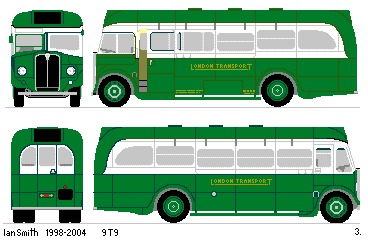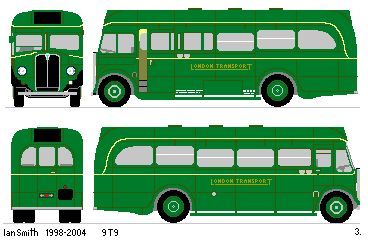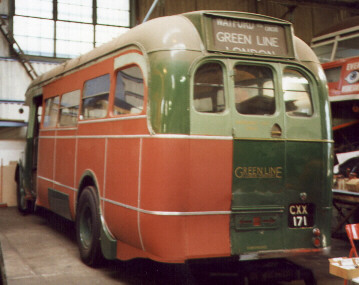
LONDON TRANSPORT T CLASS
AEC Regal single-deckers
This page prepared by Ian Smith, created 15th August 1999, updated 7th March 2003.
9T9 Regals: T403- T452 (total 50)The 9T9 Regals were ordered by LT in 1936 to help replace the motley fleet of Gilford coaches that were still working GreenLine services. (Side-engined Q coaches were ordered at the same time to complete the replacement).
They went into service during the 1936 summer season,
but soon proved to be underpowered for the GreenLine schedules.
The 10T10s and TFs introduced in 1939 proved much better,
and more than half the 9T9s were officially demoted to bus service before the end of 1939.
The GreenLine services were suspended during the war, and the coaches were placed on ambulance duty. LT quickly swapped 9T9s for 10T10s, leaving the better-powered buses on bus duties and the underpowered 9T9s on the less intensive ambulance work. Their combined headlamp and sidelight housing required some ingenious modification to comply with the blackout regulations. Six were loaned to the US Army between 1942 and 1946. Five were returned. After the war most of the recruits were restored to GreenLine condition, but all the 9T9s were quickly reclassified as buses, and were repainted to green with white window surrounds. Some later received the post-war Country Area livery of overall green with cream lining.
They continued in bus service, some being loaned to the Central Area. Uxbridge (UX) used eight on the 222, 223 and 224, and Hornchurch (RD) six on the 250. They were heartily disliked by the Central crews. They remained green. In the Country Area they were used mainly at Leatherhead, Addlestone, Luton, St.Albans, Hertford and Dunton Green. The introduction of RFs to Green Line services was their doom, as this released 10T10s to allow withdrawal of the unpopular 9T9s and the 11T11s. and they were all retired in early 1952 and sold by the end of 1953. T448 survived into preservation, and is currently undergoing repanelling and repainting at Cobham Bus Museum.
T448 at Cobham Bus Museum, October 1997
|
 They were a new generation of Regals for LT, using the longer 17ft 6in wheelbase chassis
and a 7.7 litre diesel engine. They were longer in the body too, at 27ft 6in.
These bodies incorporated the current art-deco ideas,
with the front wing faired into the body along with the bonnet and radiator surround.
A forward sliding door opened into a separate compartment within the body.
A front bumper completed the rather heavy front treatment.
Fairings behind the wheel arches, similar to those on contemporary STLs,
were another concession to the thirties' pre-occupation with streamlining.
Despite the extra length they still seated thirty, allowing a little extra leg-room.
They were a new generation of Regals for LT, using the longer 17ft 6in wheelbase chassis
and a 7.7 litre diesel engine. They were longer in the body too, at 27ft 6in.
These bodies incorporated the current art-deco ideas,
with the front wing faired into the body along with the bonnet and radiator surround.
A forward sliding door opened into a separate compartment within the body.
A front bumper completed the rather heavy front treatment.
Fairings behind the wheel arches, similar to those on contemporary STLs,
were another concession to the thirties' pre-occupation with streamlining.
Despite the extra length they still seated thirty, allowing a little extra leg-room.



 T403-452: 9T9 histories
T403-452: 9T9 histories Bus Stop
Bus Stop T contents
T contents 11T11s
11T11s 9T9s
9T9s